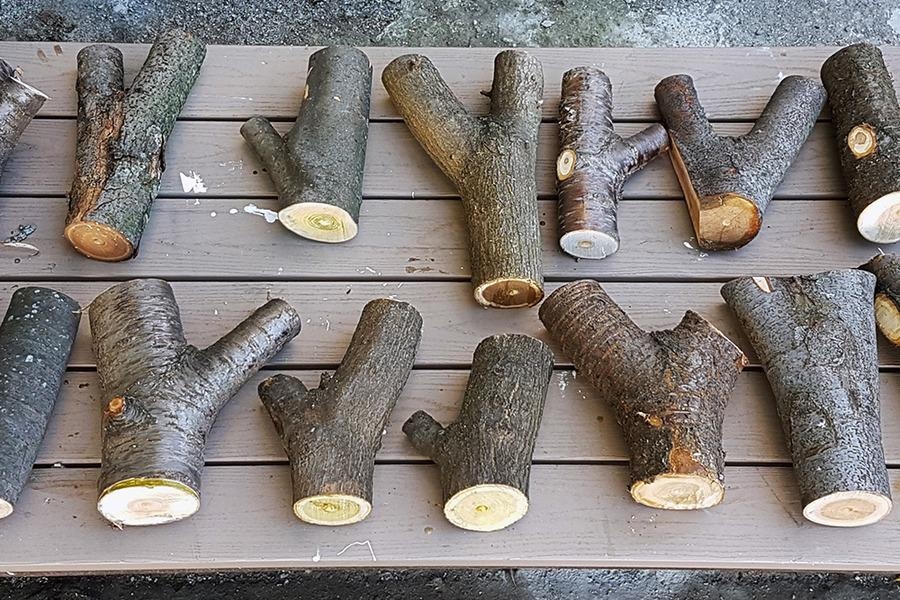Researchers at MIT have developed a novel approach for manufacturing load-bearing joints using discarded tree forks. Their innovative system combines numerical modeling, 3D printing and robotic automation to dramatically reduce complex, time-consuming machining.
 Image Credit: Stauffer, N., (2022) Using nature’s structures in wooden buildings [online] Available at: https://news.mit.edu/2022/using-natures-structures-wooden-buildings-0309
Image Credit: Stauffer, N., (2022) Using nature’s structures in wooden buildings [online] Available at: https://news.mit.edu/2022/using-natures-structures-wooden-buildings-0309
Increasing concerns about climate change have focused attention on the construction industry which is heavily reliant on metals and minerals extracted from the Earth. As wood naturally sequesters carbon, there have been growing calls for the increased use of timber in building construction.
Tree forks are naturally engineered structural connections that work as cantilevers in trees, which means that they have the potential to transfer force very efficiently thanks to their internal fiber structure.
Caitlin Mueller, Digital Structures Research Group, MIT
A Brief Primer on Tree Fork Structures
Tree forks are morphological structures occasioned by a bifurcation in tree trunks resulting in two or more branches of roughly equal diameters. As the aim in commercial wood production is to produce as much straight-grained wood as possible, tree forks are normally regarded as structural defects.
However, studies on hazel trees have shown that tree forks present a unique wood grain pattern that interlocks and serves to provide mechanical support for its branches. This is likely to be true for all woody plants.
Tree forks may be genetically inherent — such as main forks — or produced by environmental factors — such as accidental forks. Additionally, these forks may be a permanent or temporary feature.
The complex interlocking wood grain patterns found in tree forks present an ideal solution for architects seeking to produce T-shaped and Y-shaped components for their structural designs.
Using Tree Fork Structures in Building Designs
Traditionally, the timber industry extracts wood from straight sections of trees. Irregular sections such as forks and knots are either ground up or burned, thereby releasing the carbon trapped in the wood into the atmosphere.
Caitlin Mueller, however, an associate professor of civil and environmental engineering at MIT, has different ideas.
Together with her colleagues in the Digital Structures group — which brings together architectural, structural engineering and computational disciplines — she has been working on ways of using discarded wood as structural components in buildings.
Specifically, she has been focusing on tree forks where the trunk of a tree separates into a Y-shaped piece with three straight sections of roughly equal diameter. Y-shaped nodes are typical architectural designs where straight elements fuse together to support critical loads.
The greatest value you can give to a material is to give it a load-bearing role in a structure.
Caitlin Mueller, Digital Structures Research Group, MIT
The Digital Structures group developed a five-step “design-to-fabrication workflow” that starts with sourcing suitable tree forks and ends with robot-assisted manufacturing. The team enlisted the help of the Urban Forestry Division of the City of Somerville, Massachusetts, which holds a digital inventory of some 2,000 trees.
The first step in the workflow was to produce a digital inventory of tree forks collected. They cut off excess material and generated a 3D scan of each individual fork. This was done using inexpensive equipment, sometimes even using a simple smartphone app.
In the second step of their workflow, the researchers wanted to quantify how well tree fork geometries matched recognized design nodes.
They aimed to produce the optimal distribution of tree fork geometries against required design nodes. Using a so-called Hungarian algorithm, the team concluded that the best distribution was a 3:1 ratio of forks to nodes.
In the third step, the team wanted to incorporate designer preferences into their workflow. They incorporated a few critical parameters, such as bending strain and bar length, which any designer could manipulate to achieve a desired shape. With each design change, the Hungarian algorithm would recalculate the optimal fork-to-node distribution.
In the fourth step of the workflow, the team developed an algorithm that calculates the cuts needed to fit each fork into a node while also minimizing expensive machining processes.
They then employed the facilities at the Autodesk Boston Technology Center Build Space, where they programmed a robotic arm to push each tree fork through a band saw in different orientations. The robot also drilled holes for structural connections.
The fifth and final step of the workflow involved the assembly of the Y-shaped joints. Even though the tree fork joints are irregular, joining them with pre-cut straight wooden elements was actually straightforward as they were all labeled.
It’s like a child’s toy set. You just follow the instructions on the joints to put all the pieces together.
Caitlin Mueller, Digital Structures Research Group, MIT
The MIT team has shown that computational techniques can be used to produce optimally cut wood joints that retain their original grain structure.
[Our approach is] at least potentially scalable and potentially achievable within our industrialized materials processing systems.
Caitlin Mueller, Digital Structures Research Group, MIT
Such a combination of novel computational techniques with design tools paves the way for architects and engineers to explore new structural forms.
References and Further Reading
Drénou, C., et al., (2020) Demystifying Tree Forks: Vices and Virtues of Forks in Arboriculture. Journal of Botany Research, [online] Vol 3 Issue 1 Pages 100-113. Available at: https://scholars.direct/Articles/botany/jbr-3-012.php
Stauffer, N., (2022) Using nature’s structures in wooden buildings [online] Available at: https://news.mit.edu/2022/using-natures-structures-wooden-buildings-0309
Disclaimer: The views expressed here are those of the author expressed in their private capacity and do not necessarily represent the views of AZoM.com Limited T/A AZoNetwork the owner and operator of this website. This disclaimer forms part of the Terms and conditions of use of this website.